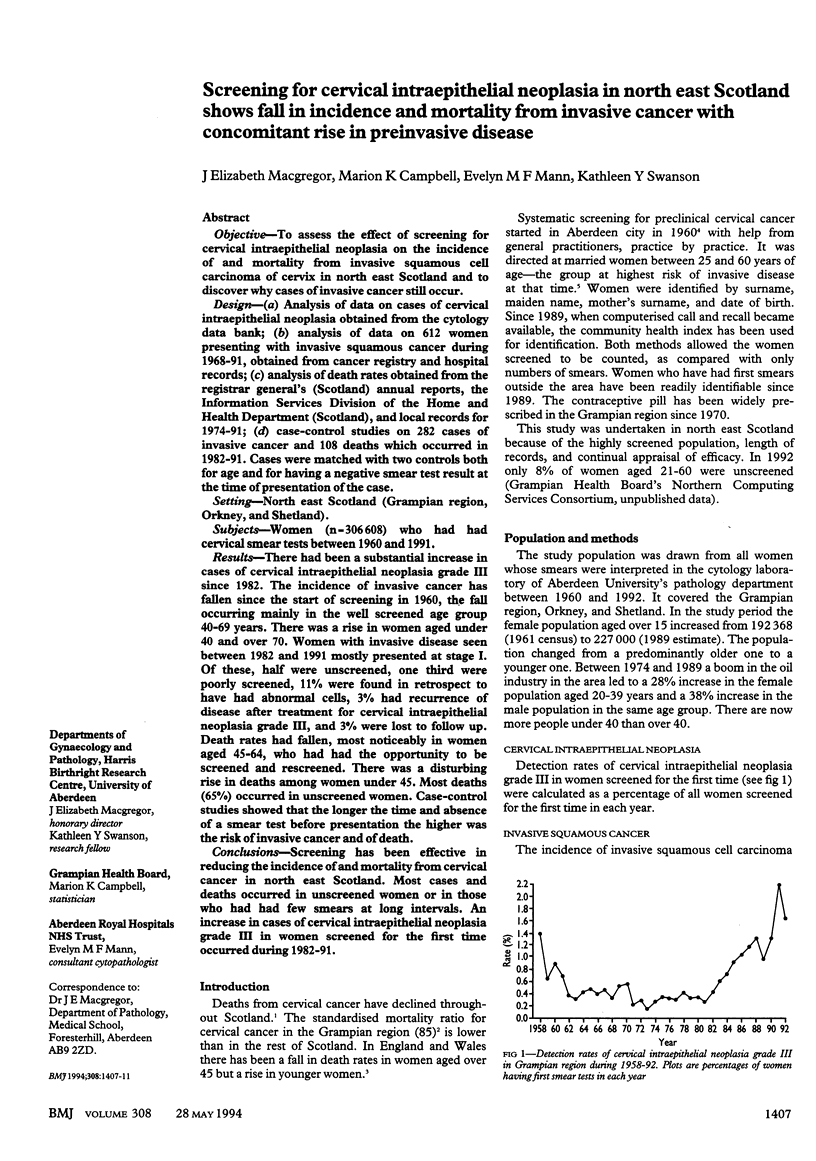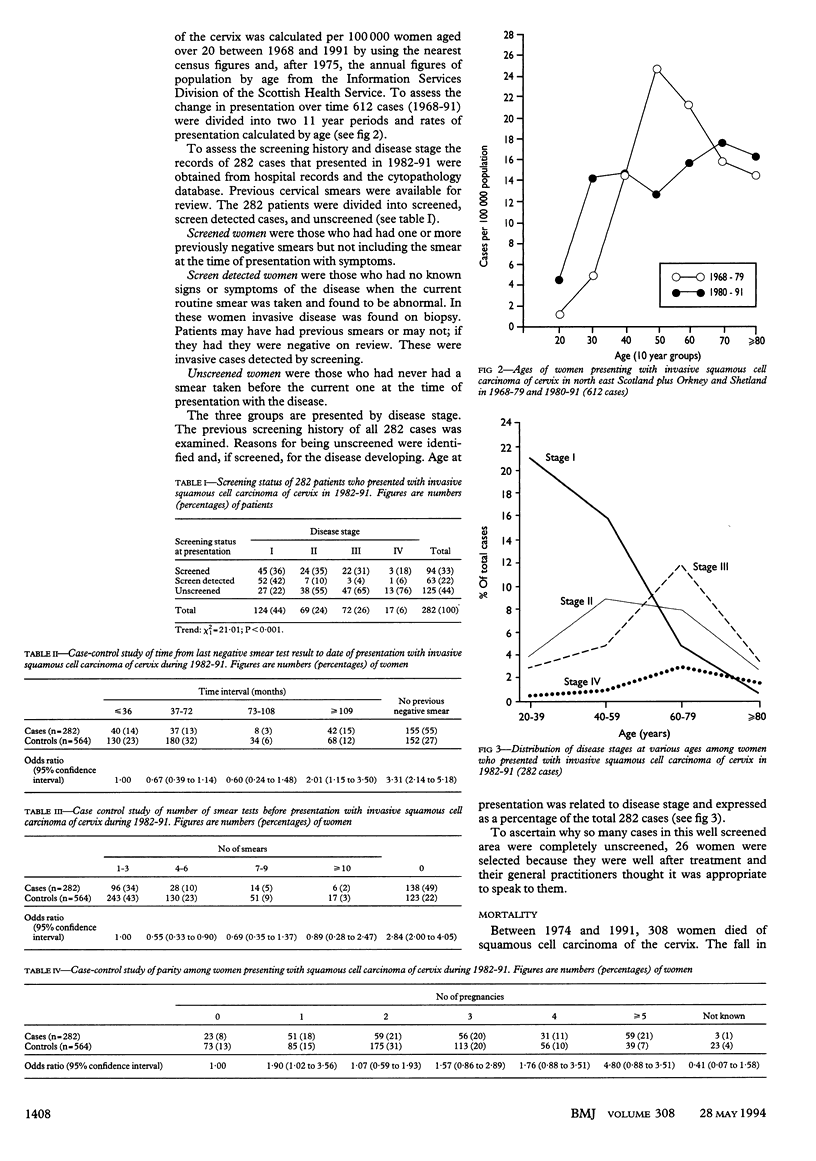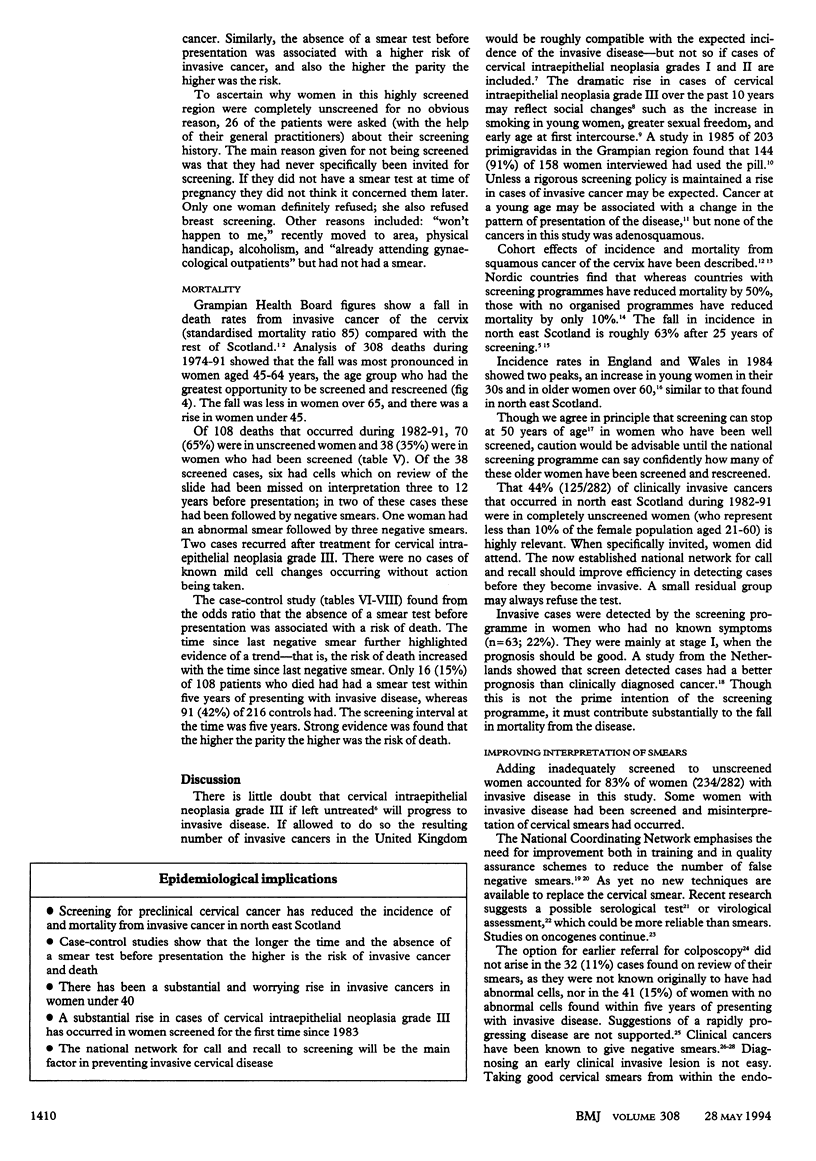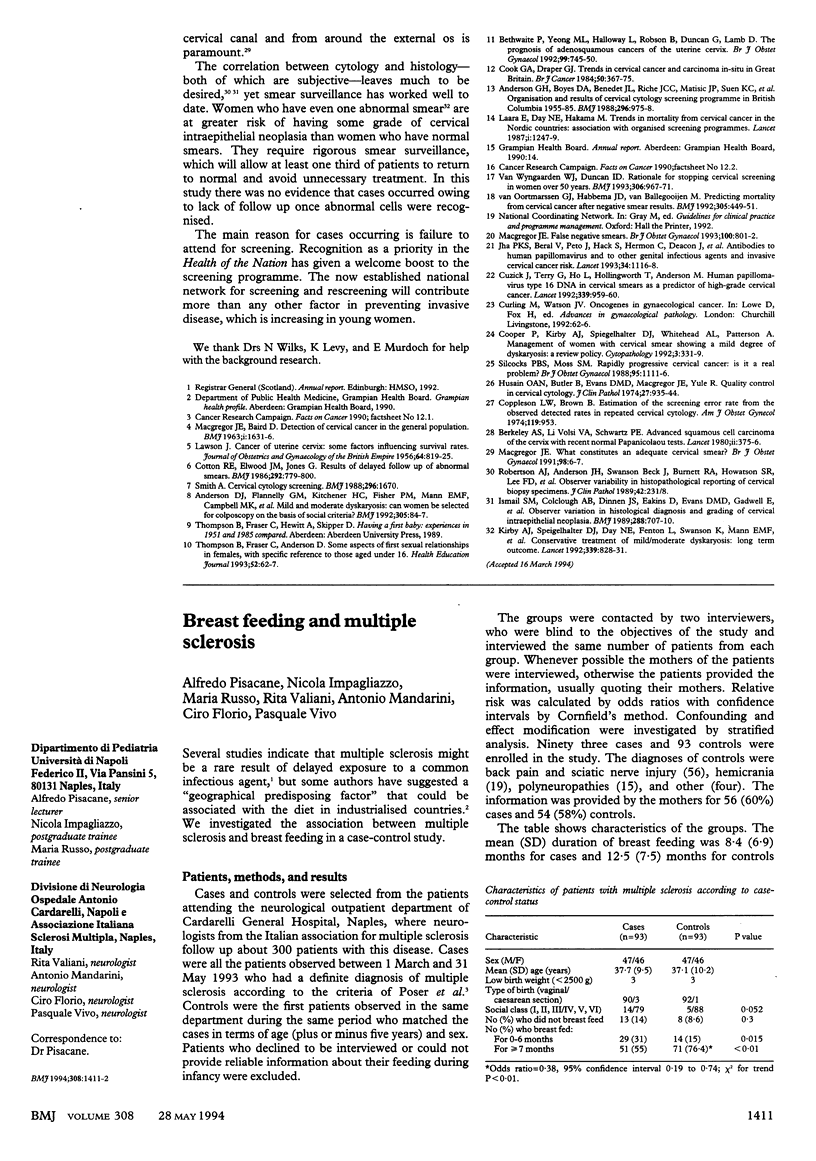Abstract
OBJECTIVE--To assess the effect of screening for cervical intraepithelial neoplasia on the incidence of and mortality from invasive squamous cell carcinoma of cervix in north east Scotland and to discover why cases of invasive cancer still occur. DESIGN--(a) Analysis of data on cases of cervical intraepithelial neoplasia obtained from the cytology data bank; (b) analysis of data on 612 women presenting with invasive squamous cancer during 1968-91, obtained from cancer registry and hospital records; (c) analysis of death rates obtained from the registrar general's (Scotland) annual reports, the Information Services Division of the Home and Health Department (Scotland), and local records for 1974-91; (d) case-control studies on 282 cases of invasive cancer and 108 deaths which occurred in 1982-91. Cases were matched with two controls both for age and for having a negative smear test result at the time of presentation of the case. SETTING--North east Scotland (Grampian region, Orkney, and Shetland). SUBJECTS--Women (n = 306,608) who had had cervical smear tests between 1960 and 1991. RESULTS--There had been a substantial increase in cases of cervical intraepithelial neoplasia grade III since 1982. The incidence of invasive cancer has fallen since the start of screening in 1960, the fall occurring mainly in the well screened age group 40-69 years. There was a rise in women aged under 40 and over 70. Women with invasive disease seen between 1982 and 1991 mostly presented at stage I. Of these, half were unscreened, one third were poorly screened, 11% were found in retrospect to have had abnormal cells, 3% had recurrence of disease after treatment for cervical intraepithelial neoplasia grade III, and 3% were lost to follow up. Death rates had fallen, most noticeably in women aged 45-64, who had had the opportunity to be screened and rescreened. There was a disturbing rise in deaths among women under 45. Most deaths (65%) occurred in unscreened women. Case-control studies showed that the longer the time and absence of a smear test before presentation the higher was the risk of invasive cancer and of death. CONCLUSIONS--Screening has been effective in reducing the incidence of and mortality from cervical cancer in north east Scotland. Most cases and deaths occurred in unscreened women or in those who had had few smears at long intervals. An increase in cases of cervical intraepithelial neoplasia grade III in women screened for the first time occurred during 1982-91.
Full text
PDF




Selected References
These references are in PubMed. This may not be the complete list of references from this article.
- Anderson D. J., Flannelly G. M., Kitchener H. C., Fisher P. M., Mann E. M., Campbell M. K., Templeton A. Mild and moderate dyskaryosis: can women be selected for colposcopy on the basis of social criteria? BMJ. 1992 Jul 11;305(6845):84–87. doi: 10.1136/bmj.305.6845.84. [DOI] [PMC free article] [PubMed] [Google Scholar]
- Anderson G. H., Boyes D. A., Benedet J. L., Le Riche J. C., Matisic J. P., Suen K. C., Worth A. J., Millner A., Bennett O. M. Organisation and results of the cervical cytology screening programme in British Columbia, 1955-85. Br Med J (Clin Res Ed) 1988 Apr 2;296(6627):975–978. doi: 10.1136/bmj.296.6627.975. [DOI] [PMC free article] [PubMed] [Google Scholar]
- Berkeley A. S., LiVolsi V. A., Schwartz P. E. Advanced squamous cell carcinoma of the cervix with recent normal Papanicolaou tests. Lancet. 1980 Aug 16;2(8190):375–376. doi: 10.1016/s0140-6736(80)90378-5. [DOI] [PubMed] [Google Scholar]
- Bethwaite P., Yeong M. L., Holloway L., Robson B., Duncan G., Lamb D. The prognosis of adenosquamous carcinomas of the uterine cervix. Br J Obstet Gynaecol. 1992 Sep;99(9):745–750. doi: 10.1111/j.1471-0528.1992.tb13877.x. [DOI] [PubMed] [Google Scholar]
- Cook G. A., Draper G. J. Trends in cervical cancer and carcinoma in situ in Great Britain. Br J Cancer. 1984 Sep;50(3):367–375. doi: 10.1038/bjc.1984.185. [DOI] [PMC free article] [PubMed] [Google Scholar]
- Cooper P., Kirby A. J., Spiegelhalter D. J., Whitehead A. L., Patterson A. Management of women with a cervical smear showing a mild degree of dyskaryosis: a review of policy. Cytopathology. 1992;3(6):331–339. doi: 10.1111/j.1365-2303.1992.tb00058.x. [DOI] [PubMed] [Google Scholar]
- Coppleson L. W., Brown B. Estimation of the screening error rate from the observed detection rates in repeated cercival cytology. Am J Obstet Gynecol. 1974 Aug 1;119(7):953–958. doi: 10.1016/0002-9378(74)90013-1. [DOI] [PubMed] [Google Scholar]
- Cotton R. E., Elwood J. M., Jones G. M. Results of delayed follow up of abnormal cervical smears. Br Med J (Clin Res Ed) 1986 Mar 22;292(6523):799–800. doi: 10.1136/bmj.292.6523.799-a. [DOI] [PMC free article] [PubMed] [Google Scholar]
- Cuzick J., Terry G., Ho L., Hollingworth T., Anderson M. Human papillomavirus type 16 in cervical smears as predictor of high-grade cervical intraepithelial neoplasia [corrected]. Lancet. 1992 Apr 18;339(8799):959–960. doi: 10.1016/0140-6736(92)91532-d. [DOI] [PubMed] [Google Scholar]
- Husain O. A., Butler E. B., Evans D. M., Macgregor J. E., Yule R. Quality control in cervical cytology. J Clin Pathol. 1974 Dec;27(12):935–944. doi: 10.1136/jcp.27.12.935. [DOI] [PMC free article] [PubMed] [Google Scholar]
- Jha P. K., Beral V., Peto J., Hack S., Hermon C., Deacon J., Mant D., Chilvers C., Vessey M. P., Pike M. C. Antibodies to human papillomavirus and to other genital infectious agents and invasive cervical cancer risk. Lancet. 1993 May 1;341(8853):1116–1118. doi: 10.1016/0140-6736(93)93128-n. [DOI] [PubMed] [Google Scholar]
- Kirby A. J., Spiegelhalter D. J., Day N. E., Fenton L., Swanson K., Mann E. M., Macgregor J. E. Conservative treatment of mild/moderate cervical dyskaryosis: long-term outcome. Lancet. 1992 Apr 4;339(8797):828–831. doi: 10.1016/0140-6736(92)90278-b. [DOI] [PubMed] [Google Scholar]
- LAWSON J. G. Cancer of the uterine cervix: some factors influencing survival rates. J Obstet Gynaecol Br Emp. 1956 Dec;63(6):819–825. doi: 10.1111/j.1471-0528.1956.tb05568.x. [DOI] [PubMed] [Google Scholar]
- Lără E., Day N. E., Hakama M. Trends in mortality from cervical cancer in the Nordic countries: association with organised screening programmes. Lancet. 1987 May 30;1(8544):1247–1249. doi: 10.1016/s0140-6736(87)92695-x. [DOI] [PubMed] [Google Scholar]
- Macgregor J. E., Baird D. Detection of Cervical Carcinoma in the General Population. Br Med J. 1963 Jun 22;1(5346):1631–1636. doi: 10.1136/bmj.1.5346.1631. [DOI] [PMC free article] [PubMed] [Google Scholar]
- Macgregor J. E. False negative cervical smears. Br J Obstet Gynaecol. 1993 Sep;100(9):801–802. doi: 10.1111/j.1471-0528.1993.tb14301.x. [DOI] [PubMed] [Google Scholar]
- Macgregor J. E. What constitutes an adequate cervical smear? Br J Obstet Gynaecol. 1991 Jan;98(1):6–7. doi: 10.1111/j.1471-0528.1991.tb10302.x. [DOI] [PubMed] [Google Scholar]
- Robertson A. J., Anderson J. M., Beck J. S., Burnett R. A., Howatson S. R., Lee F. D., Lessells A. M., McLaren K. M., Moss S. M., Simpson J. G. Observer variability in histopathological reporting of cervical biopsy specimens. J Clin Pathol. 1989 Mar;42(3):231–238. doi: 10.1136/jcp.42.3.231. [DOI] [PMC free article] [PubMed] [Google Scholar]
- Silcocks P. B., Moss S. M. Rapidly progressive cervical cancer: is it a real problem? Br J Obstet Gynaecol. 1988 Nov;95(11):1111–1116. doi: 10.1111/j.1471-0528.1988.tb06787.x. [DOI] [PubMed] [Google Scholar]
- Van Wijngaarden W. J., Duncan I. D. Rationale for stopping cervical screening in women over 50. BMJ. 1993 Apr 10;306(6883):967–971. doi: 10.1136/bmj.306.6883.967. [DOI] [PMC free article] [PubMed] [Google Scholar]
- van Oortmarssen G. J., Habbema J. D., van Ballegooijen M. Predicting mortality from cervical cancer after negative smear test results. BMJ. 1992 Aug 22;305(6851):449–451. doi: 10.1136/bmj.305.6851.449. [DOI] [PMC free article] [PubMed] [Google Scholar]


